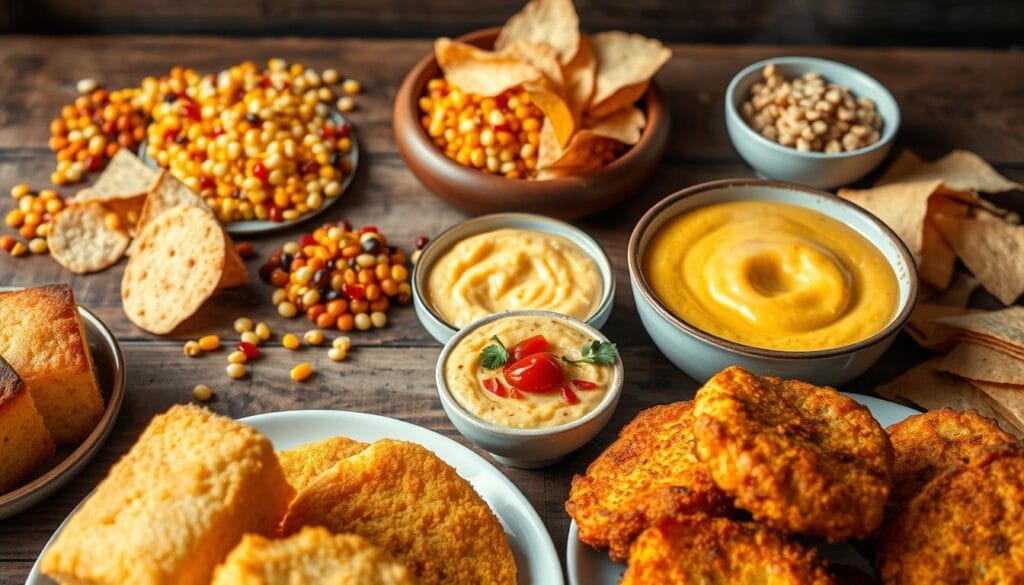Are you thinking about adding grits to your diet? Good news: yes, Are Grits Gluten Free. This makes them perfect for those with gluten intolerance or celiac disease. Grits come from dried, ground dent corn, which is high in starch and low in calories and fat.
With more people following gluten-free diets, it’s important to know if grits fit the bill. Grits can be a tasty and healthy part of your meals. They’re packed with B vitamins and iron, making them a nutritious choice.
Looking for a gluten-free breakfast option or curious about gluten-free grits? This guide has all the info you need. Let’s explore the world of gluten-free grits together.
Key Takeaways
- Grits are naturally gluten-free, making them a great option for those with gluten intolerance or celiac disease.
- Grits are made from dried, ground dent corn and are low in calories and fat.
- Grits are high in B vitamins and iron, making them a nutritious choice.
- Some brands of grits may be processed and stored with wheat products, leading to a risk of cross-contamination.
- It is recommended to check for a gluten-free label on packaging to ensure compliance with U.S. Food and Drug Administration standards.
- You can enjoy gluten free grits as a nutritious and delicious addition to your meal plan.
Understanding What Grits Are Made From
Grits are a favorite breakfast dish made from ground corn. Knowing their gluten content in grits is key for those with celiac disease. Traditional grits come from dent corn, which is sweeter and starchier than other types.
The corn is ground into fine or medium textures, depending on the grits type. You can find stone-ground, quick, instant, and hominy grits. Each has its own taste and nutritional value. When wondering are grits safe for celiac, picking a gluten-free type is important.
When looking at gluten content in grits, consider the corn type, how they’re made, and cross-contamination risks. Knowing these helps you pick the right grits and cook them safely. Whether you prefer stone-ground, quick, or instant, there’s a type for everyone’s taste and diet.
Are Grits Gluten Free? The Simple Answer
Grits are naturally gluten-free because they come from corn. Corn doesn’t have gluten. This makes them a good choice for those who need celiac friendly grits. But, it’s important to think about how they’re made and if they might get gluten from other grains.
When we talk about gluten in cornmeal, remember that corn itself is gluten-free. The problem comes when the same tools are used for gluten grains. This can cause gluten to mix with the corn. People with celiac disease or gluten intolerance should make sure their grits come from a place that only makes gluten-free products.
To get gluten-free grits, look for brands that say they are gluten-free. Brands like Arrowhead Mills and Bob’s Red Mill have gluten-free grits. Always check the label and look for special symbols to make sure it’s right for you.
The Science Behind Grits and Gluten
Corn, the main ingredient in grits, doesn’t have gluten. This makes grits a perfect gluten free breakfast option for people with gluten issues. It’s important to know why grits are gluten-free.
Corn’s natural makeup and gluten’s structure make grits safe for those with gluten sensitivity. But, it’s crucial to watch out for gluten contamination during making.
- Grits are usually gluten-free because they’re made from corn, which lacks gluten.
- About 13% of the world’s people are sensitive to gluten in their diet.
- Grits are rich in fiber, helping with digestion and gut health.
In summary, the science is clear: grits are naturally gluten-free. They’re a great gluten free breakfast option for those with gluten intolerance or celiac disease.
Common Sources of Gluten Contamination in Grits
When we talk about gluten free corn products, it’s key to know that are grits gluten free naturally. But, they can get contaminated during processing. Knowing where gluten can get into grits helps you make better choices.
Gluten can get into grits during making, especially if the same tools are used for gluten grains. Some grits might have gluten because of added flavors or ingredients. Also, how they’re handled or stored can bring gluten into gluten-free grits.
It’s important to know these risks to make sure you get gluten-free grits. You can lower the chance of gluten getting into your grits by picking certified gluten-free ones. Also, pay attention to how they’re made.
- Look for certification from trusted groups
- Check the ingredients for gluten
- Understand the making process and cross-contamination risks
By knowing where gluten can get into grits and taking steps to avoid it, you can enjoy gluten-free grits. They can be a healthy part of your diet.
Reading Grits Labels for Gluten Safety
When you’re looking for gluten free grits, it’s key to read the labels well. Look for symbols like the Gluten-Free Certification Organization (GFCO) or the Celiac Support Association (CSA). These symbols mean the product has been tested and is gluten-free.
It’s also important to understand the ingredient list. Check for gluten-containing ingredients. Be cautious of warning statements about allergens. For those with celiac disease or gluten intolerance, this info is crucial to stay safe.
- Certification symbols: Look for the GFCO or CSA logo to ensure the product is gluten-free.
- Ingredient list: Check for any gluten-containing ingredients and be aware of warning statements.
- Warning statements: Pay attention to statements regarding allergens and potential cross-contamination.
By carefully reading grits labels, you can make sure the gluten free grits you pick are safe. Always check the label before buying. Remember, are grits safe for celiac? The answer is in the label.
Best Brands of Certified Gluten-Free Grits
Choosing the right brand of gluten-free grits is key. Look for brands that make their products in dedicated gluten-free facilities. This way, you avoid cross-contamination. Arrowhead Mills, Bob’s Red Mill, and Carolina Grits are some top brands that offer certified gluten-free grits.
These brands take the gluten in cornmeal seriously. They make sure to prevent cross-contamination.
Some notable brands that offer certified gluten-free grits include:
- Palmetto Farms, which has been producing grits in South Carolina since 1934
- Judee’s, which offers flavored gluten-free grits such as Creamy Parmesan Mushroom and Jalapeno Cheddar Cheese
- Bob’s Red Mill, which produces gluten-free grits in a dedicated facility
- Carolina Grits, which produces their certified gluten-free grits in small batches using traditional stone grinding techniques
These brands are dedicated to offering high-quality, gluten-free grits. They meet strict gluten-free standards. By choosing certified gluten-free grits, you get to enjoy the nutritional benefits of grits. This includes iron and carbohydrates, without gluten.
Always check the label for certification symbols. Look for the Gluten-Free Certification Organization (GFCO) or the Celiac Support Association (CSA). This ensures the product meets your dietary needs. With many great brands to choose from, you can enjoy delicious and safe gluten-free grits, free from gluten in cornmeal.
Safe Preparation Methods for Gluten-Free Grits
To enjoy a delicious and safe gluten free breakfast option, it’s key to prepare your grits with care. When exploring celiac friendly grits, remember cross-contamination is a big concern. By following a few simple steps, you can reduce the risk of gluten exposure and enjoy your grits with confidence.
Begin by setting aside a specific area in your kitchen for gluten-free food prep. This helps avoid cross-contamination with gluten. When cooking your grits, use only gluten-free cooking tools and utensils to stay safe.
Kitchen Cross-Contamination Prevention
- Use separate cooking utensils and equipment for gluten-free foods
- Designate a specific area for gluten-free food preparation
- Regularly clean and sanitize your kitchen surfaces and equipment
Essential Cooking Tools
To safely and efficiently prepare your grits, you’ll need a few key tools. These include a large pot, a strainer, and a whisk. These tools help ensure your grits are cooked just right and stay gluten-free.
By following these guidelines and using the right tools, you can enjoy a delicious and safe gluten free breakfast option. Whether you’re after a hearty breakfast or a quick snack, celiac friendly grits are a great choice.
Nutritional Benefits of Gluten-Free Grits
Gluten-free grits are a healthy breakfast choice. They are made from gluten free corn products. This makes them a good source of complex carbs for lasting energy.
They are also low in fat and calories. This makes them great for those trying to manage their weight. Plus, they have iron and folate. Iron helps with blood health and oxygen transport. Folate is key for cell growth and DNA.
For those with gluten intolerance or sensitivity, are grits gluten free is a yes. Gluten-free grits are also high in fiber. This helps with digestion and supports gut health.
They also have selenium, an antioxidant that boosts the immune system. And they’re packed with B vitamins, including thiamin. Thiamin helps turn food into energy. So, gluten-free grits are a nutritious addition to any diet.
Gluten-free grits offer many nutritional benefits. They are low in fat and calories. They are a good source of complex carbs, iron, and folate.
They also have fiber, selenium, and B vitamins. These include thiamin, which helps convert food into energy. So, gluten-free grits are a nutritious and tasty choice for a gluten-free breakfast.
Common Mistakes When Preparing Gluten-Free Grits
When making gluten free grits, it’s key to know common mistakes. These can make your grits not gluten-free. You might wonder, are grits safe for celiac patients if not made right. To keep your diet gluten-free, watch out for storage, cooking, and contamination issues.
Staying away from these errors needs focus and knowing how to prepare gluten-free foods. For example, keep cooked gluten free grits in an airtight container in the fridge for up to 1 week. Or freeze them for up to 3 months to avoid contamination. Also, use a 1:4 ratio of grits to liquid and cook them for the right time to avoid cooking mistakes.

- Improper storage, which can lead to cross-contamination with gluten-containing foods
- Cooking errors, such as using too much liquid or not cooking the grits for the recommended time
- Contamination risks, such as using utensils or equipment that have come into contact with gluten-containing foods
By being careful of these common mistakes, you can make sure your gluten free grits are safe. This is true even for those with celiac disease or gluten intolerance.
Alternatives to Traditional Grits for Gluten-Sensitive People
If you’re gluten-sensitive but don’t need a gluten-free diet, there are other grits you can try. These are made from grains or pseudo-grains that don’t have much gluten content in grits or gluten in cornmeal. Rice, quinoa, and buckwheat grits are good examples.
These grits taste and feel like the real thing but are healthier. For instance, quinoa grits are packed with protein and fiber. They’re perfect for a nutritious breakfast. Plus, many of these grits are made from cornmeal that’s naturally gluten-free.
When looking for these grits, always check the labels for gluten content in grits and other ingredients. Some brands are certified gluten-free, making it easier to find a tasty alternative to traditional grits.
There are many grits options for those who are gluten-sensitive. By looking at the gluten content in grits and gluten in cornmeal, you can find a safe and delicious breakfast that fits your diet.
Health Considerations for Celiac Patients
For celiac patients, eating gluten can be very harmful. When looking for a gluten free breakfast option, it’s important to avoid cross-contamination. Make sure your grits are made in a place that only makes gluten-free products.
To safely enjoy celiac friendly grits, talk to a doctor or dietitian. They can help you manage your condition and make good food choices. Some important things to remember include:
- Always check the labels for gluten-free certification
- Be aware of potential cross-contamination risks during processing
- Choose certified gluten-free grits to minimize the risk of gluten exposure
By being careful and watching your gluten intake, you can have a tasty and safe gluten free breakfast option. This way, you can keep your diet healthy.
Tips for Dining Out and Ordering Grits
For those with gluten intolerance or celiac disease, dining out can be tricky. But, grits are often a safe choice because they’re made from gluten free corn products. Still, it’s crucial to ask about how they’re prepared to avoid cross-contamination.
When you’re out, ask your server about gluten-free options. Many places now have gluten-free menus. You can also inquire about where the grits are cooked to ensure they’re safe.

- Are the grits made from gluten free corn products?
- Are the grits cooked in a dedicated gluten-free area?
- Can you provide a list of ingredients used in the grits?
By asking the right questions, you can enjoy a safe and tasty meal of grits. Always put your health first and ask about your food. If you’re not sure if are grits gluten free, it’s better to choose something else.
Incorporating Grits into Your Gluten-Free Meal Plan
Grits are a great choice for a gluten-free meal plan. They work well for breakfast, lunch, or dinner. You can make them in many ways and add different ingredients to boost their taste and nutrition. Since gluten free grits are naturally gluten-free, they’re perfect for those with gluten issues, including those who ask are grits safe for celiac patients.
To add grits to your meals, try different cooking methods. You can cook them with milk or water and season with salt, pepper, or herbs. Then, top them with your favorite foods like cheese, bacon, or eggs. For a quick breakfast, mix grits with scrambled eggs, sausage, or fruit.
- Grits bowls with roasted vegetables and lean protein
- Grits cakes with grilled chicken or fish
- Grits stuffed peppers with ground meat and cheese
These ideas show how you can use grits in your gluten-free meals. Their gluten-free nature and flexibility make them a great choice for a healthy diet.
Troubleshooting Common Issues with Gluten-Free Grits
When making gluten-free grits, you might face problems with texture or taste. It’s key to know about the gluten content in grits and how it impacts cooking. Gluten-free grits come from corn and don’t have gluten, but they can get contaminated during processing or cooking.
To avoid gluten contamination, pick a trusted brand that keeps gluten in cornmeal low. Also, use a dedicated gluten-free cooking area and tools. If the texture is off, tweak the cooking time or liquid amount to get it right.
By fixing common issues with gluten-free grits, you can have a tasty and safe breakfast. Always check the ingredient label and look for certifications to meet your dietary needs. With some practice and patience, you’ll master making gluten-free grits and enjoy their health benefits.
Conclusion
Grits can be a great choice for those with gluten-free diets. They are nutritious and can be used in many ways. By knowing how to prepare them safely, you can enjoy them while sticking to your dietary needs.
New Orleans is now a city that welcomes gluten-free eaters. Restaurants there offer everything from Eggs Sardou to vegan Philly cheesesteaks. This shows how easy it is to find gluten-free options. With a bit of effort, you can add gluten-free grits to your meals, whether it’s breakfast, lunch, or dinner.
FAQ
Are grits gluten-free?
What are grits made of?
How can I ensure grits are gluten-free?
What are the common sources of gluten contamination in grits?
What should I look for on grits labels to ensure they are gluten-free?
What are some recommended brands of certified gluten-free grits?
What are the nutritional benefits of gluten-free grits?
What are some alternatives to traditional grits for gluten-sensitive individuals?
What precautions should celiac patients take when consuming grits?
How can I incorporate gluten-free grits into my meal plan?
Table of Contents
Did you like this recipe?
There are no reviews yet. Be the first one to write one.

